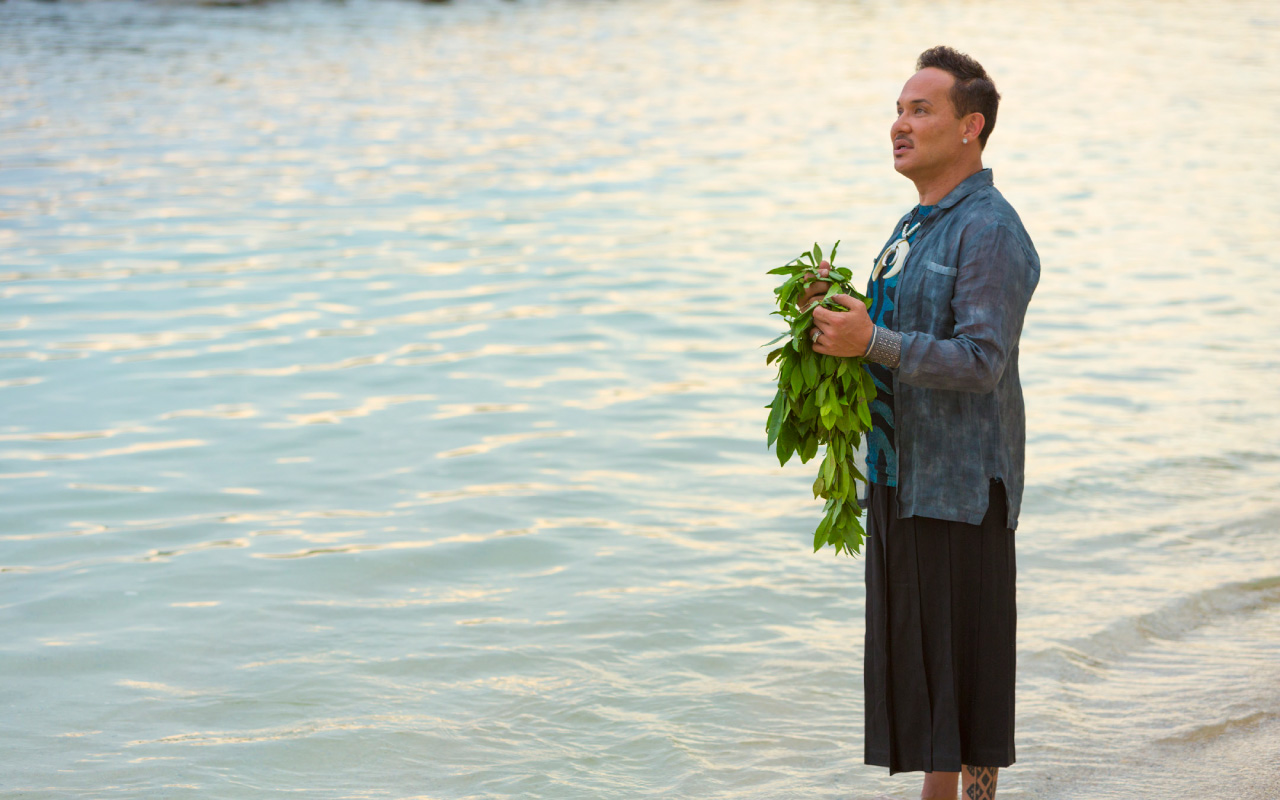The method that his grandmother used to teach hula and chant was by imitation. This is also the way Sonny teaches today. “We just repeated this process until she felt I was doing it correctly. She chanted. I chanted. She danced. I danced. I was not allowed to write anything which was good because when you learn strictly through memory, things tend to stay with you longer.”
“My grandmother told me I can never set up a kuahu because my hālau is to be dedicated to God. But it was alright to do the chants that honor Laka because those chants need to continue otherwise it would be forgotten. For us, this is part of the ritual that prepares us spiritually, physically, and mentally for the hula. This is one of the ways we build our mana.”
When Sonny was fifteen, his grandmother gave him permission to experience being in a hālau. This marked Sonny’s beginning with Frank Kawaikapuokalani Hewett.
“It was incredible to belong to his hālau. The mana within the hālau was very strong and you could feel the spirit permeate the air. The students had so much aloha for each other and they were so willing to spend extra time to help you learn. I was never one of his best students. I know that I did not get enough of all he had to offer. He has so much knowledge of the culture: his whole lifestyle lives and breathes the culture. This is probably the greatest lesson I have learned from him. Becoming a kumu hula doesn’t mean you just teach hula. Becoming and being a kumu hula dictates your whole lifestyle. It dictates the way you think, your action, and your view on life. All of these things are interrelated.”
Sonny danced with Frank for about three years and it was Frank who gave Sonny the name he uses today: Kahakuleilehua. After moving to town it became too difficult for Sonny to continue commuting to He‘eia on the bus with all of his hula implements. Sonny’s other interests also started playing a more important role in his life. At the time, Sonny admits that he did not have the dedication, discipline, and strong enough desire to continue dancing hula.
After about a year and a half break, Sonny started dancing hula with Lāhela Ka‘aihue. It was Lāhela who truly taught him to love the hula ‘auana.
“She is such a beautiful dancer. I could sit for hours and watch her dance. The style of dancing that we do, especially the men’s auana, is really Lāhela.”
As Sonny got older, he realized the importance of teaching hula. In 1986 Moses Crabbe asked him to take over his class at Pākī Park. Sonny accepted the request and has been teaching kūpuna at Pākī Park to this day. Some of the kūpuna in the class today are the same ladies from that original class.
In 1986 Sonny established Hālau Nā Mamo O Pu‘uanahulu which is currently located in Honolulu.
“For any of my students to become kumu hula, they need to be stronger in the Hawaiian language. They need to have better understanding of the poetry of the chants and to understand the kaona or the hidden meaning of the chants. I require them to learn all of the kuahu chants and the dressing chants. In addition, I think it is very important that kumu hula are able to choreograph, create, write, take a chant from the 1600s or 1700s and put it into hula movements today.
“I cannot say that what we do is what the teachers of old would do. It is good that some hula masters perpetuated things exactly as they were taught to them. And it is through their teachings that we will always have what was from a time before us.
“I honor this, but feel that my job is to both perpetuate hula in the ancient styles while incorporating my soul and personal style; to not be too loud or outrageous in the kahiko movements. It needs to be done within these guidelines. You need to maintain tradition even if it is choreographed today. Most importantly a kumu needs to be strong spiritually. Kumu means foundation or base and if the foundation is not strong, you cannot build upon it.
“I believe that hula is getting back to being performed more in the traditional manner. There was a period when the hula was getting a little too wild; too many introductions of other dance forms, especially to the hula kahiko. I think it turned around due to the revival of other aspects of our culture like the ‘ōlelo, oli, planting, la‘au lapa‘au, navigation, huna, lua, weaving, amongst others. I hope that people like myself and my fellow kumu hula are looking to keeping things traditional yet conducive to our times. The hula has changed over time and I think that this is a good thing or it is my belief that the hula would die. I think each of us breathe our own breath into our dance, our haumāna, our hālau. This need is why we are kumu hula. That is what makes each of us unique, different. If we did things the same, there would be no need for different hālau. A handful would suffice and we would be unable to document our times.”



